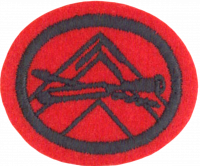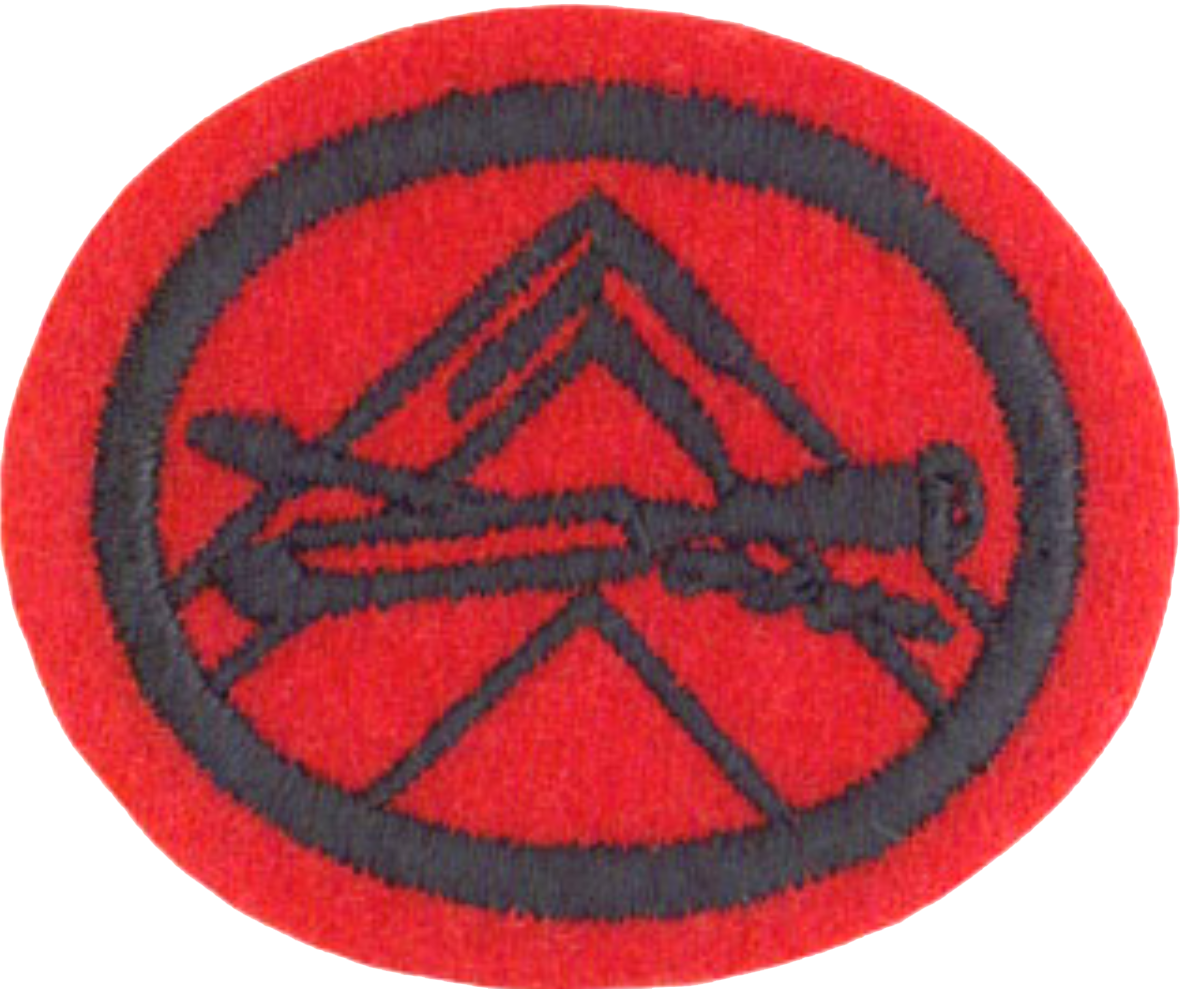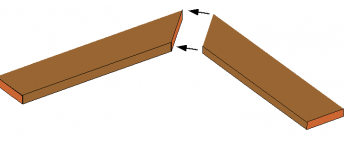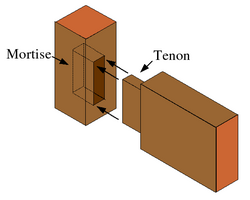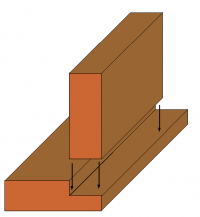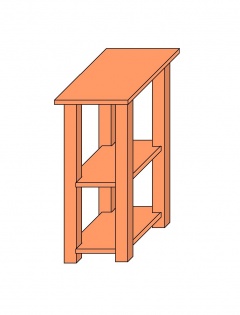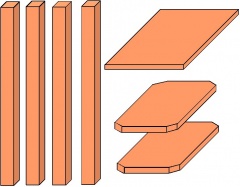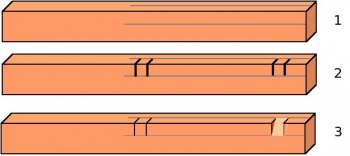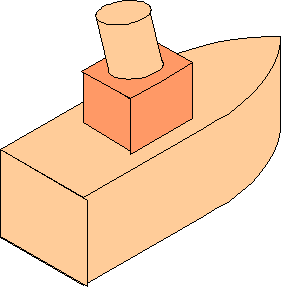Especialidades JA/Trabajos en madera/Respuestas
Nivel de destreza
2
Año
1934
Version
17.05.2024
Autoridad de aprobación
Asociación General
1
1a
1b
1c
1d
1e
1f
2
Pine is the most commonly available wood in North America. Its primary advantage is that it is relatively cheap. This is because it grows rather quickly. Another characteristic of pine is that it is soft. This can be both an advantage and a disadvantage. The advantage of a soft wood is that it is easy to work. The disadvantage is that it can break easily; delicate joinery that works fine in hardwoods will not hold up in pine. Most dimensional lumber (i.e., 2x4's) is made from pine.
3
Furniture clamps (also called bar clamps) often have padded clamping surfaces, so making unwanted impressions on the wood is avoided. These are used for clamping large boards together, usually edge-to-edge.
Clamps can be periodically wiped down with a cloth and oil to keep rust at bay.
Drills, Bits, and Braces
Drills, Bits, and Braces are used for boring holes in wood. A brace and bit is the "old-style" cordless drill. It is hand-powered. The brace holds the bit, and the woodworker's hand cranks it, inducing a rotation in the bit. To drill a clean hole with either a brace and bit or a drill and bit, hold the bit perpendicular to the board and start drilling. You can start a pilot hole with a nail or a punch first to keep the bit from wandering. There are two ways to prevent tear-out when boring a hole. The first method is to support the board and drill into the supporting material. For this to work, the board and its support must be firmly clamped together. The second method can be used if you have a bit with a point that is much narrower than the hole's diameter (such as a spade bit, a brad-point bit, or a bit with a screw-lead). Using such a bit, drill through the material until the tip comes through the other side. Then turn the board over and place the bit in this hole. Continue drilling toward the center.
4
4a
4b
4c
4d
4e
4f
A 90 degree miter joint is formed by cutting the two boards at a 45 degree angle and joining them. The choice of a miter joint is purely aesthetic. Miter joints are easy to cut with a power miter saw, but difficult to cut by hand. A miter box can help, but the angle of the cut must be very nearly perfect, or the joint will either not be 90 degrees, or it will show a gap. The gap can be eliminated by "kerfing in" the joint. Kerfing in a joint is done by clamping the two pieces together and then running a fine-toothed handsaw down the joint. Ideally, the saw should remove wood from both pieces. This procedure can be repeated until the woodworker is happy with the fit, but keep in mind that every time this procedure is performed, the board gets a little shorter. For this reason, it is best to cut the miter joint first, and then cut the piece to length. If both ends of the board are to be mitered, the board should be cut a little long and then tuned to length by kerfing it in.
Miter joints must be reinforced or they will not hold (once again, endgrain comes into play). Usually the pieces are fastened to some underlying structure so that the miter joint is not subjected to stress, nor is it relied upon for structural integrity. In other cases, the joint itself can be reinforced using dowels (as in a dowel joint) or some similar mechanism.
4g
The mortise and tenon joint is a strong joint used to join two pieces of wood usually at a 90 degree angle. The mortise is a hole cut into one of the pieces, and the tenon is shaped to fit snugly into this hole. The tenon is usually narrower than the rest of the piece that it is cut into. The joint may be glued, pinned, or wedged to lock it in place.
The mortise is usually cut first, and its width is equal to the width of the chisel used to cut it (see the section on chisels). The tenon is then sized to fit the mortise, and it is cut with a tenon saw, dovetail saw, or backsaw. The first cuts are made along the grain and are called the cheek cuts. The final cuts are made across the grain and are called the shoulder cuts. The tenon can be pared with a chisel to tune the fit.
4h
A rabbet joint is very similar to a dado joint, except that the groove is cut at the edge of the board. This groove is called a rabbet. It is also sometimes called a rebate. A rabbet joint is often used for joining the back to a cabinet or bookcase. It can be glued, held on with mechanical fasteners, or both. The rabbet can be cut in either or both pieces to be joined.
A rabbet joint can be made with a table saw or a router. It can also be made with a rabbet plane. The blade of a rabbet plane comes all the way to the edge of the tool so that it can remove wood from the corner of the rabbet.
5
5a
Hardboard (also called Masonite) is an engineered wood product made by turning wood chips into long fibers by steaming them. These fibers are then heated and pressed into a solid board. Hardboard is sold in 4'x8' sheets of various thicknesses in the United States. It is an extremely stable material, expanding and contracting very little with changes in temperature and humidity. It is highly homogeneous, having no distinct grain. Because of its lack of grain it behaves very differently as compared to regular lumber.
Hardboard has high bending strength, but has very little structural strength, so it cannot be used in many applications where plywood or regular lumber are more suited. It can be used for building arches, and its strength can be improved by laminating several sheets together. Hardboard is often used as drawer bottoms, or as the back of cabinets, etc.
5b
From Wikipedia, the free encyclopedia.
Particle board (sometimes called chipboard) is a material manufactured from wood particles (for example, wood chips, sawmill shavings, or even saw dust) and a synthetic resin or other suitable binder, which is pressed and extruded. Particle board is very dense, heavy, and flat. It is used as a cheaper and less durable substitute for solid wood or plywood. Particle board is very prone to expansion due to moisture.
Particle board should not be used in applications where it is likely to get wet. It is generally not used in furniture making unless it is covered with a veneer (or in inexpensive furniture, a vinyl covering similar to wallpaper). It is not generally finished with stain, varnish, or paint, as aesthetics are not high on its list of characteristics. It is, however used in the hidden portions of woodworking projects such as drawer backs and sides.
5c
From Wikipedia, the free encyclopedia.
Plywood was the first type of engineered wood to be invented. It is made from thin sheets of wood veneer, called plies, which are stacked together with the direction of each ply's grain differing from its neighbors by 90° (cross-banding). The plies are bonded under heat and pressure with strong adhesives, usually phenol formaldehyde resin, making plywood a type of composite material.
A vast number of varieties of plywood exist, tailored for all manner of conditions and uses. Softwood plywood is usually made either of Douglas fir or spruce, pine, and fir. Decorative plywood is usually faced with hardwood, including red oak, birch, maple, lauan (Philippine mahogany) and a large number of other hardwoods.
Plywood production requires a good log, called a peeler, generally straighter and larger in diameter than that required for processing by a sawmill. The log is peeled into sheets of veneer which are then cut to the desired dimensions, dried, patched and glued together to form the plywood panel. The panel can then be patched, resized, sanded or otherwise refinished, depending on the market it was intended to be sold in.
The most common varieties of softwood plywood comes in three, five or seven plies with dimensions of 4 feet × 8 feet. Each ply is 1/8 inch.
A common reason for using plywood instead of plain wood is because plywood is more stable and because it is less prone to change (shrink, twist or warp). Plywood is stronger than particle board and hardboard, and because the outer layers can be made from fine hardwoods, it is often used in furniture making. It is suitable for natural finishing or painting.
6
Unfortunately, some layers of plywood often have knots in them, and the knots fall out before the layers are glued together. This leaves a void. In furniture-grade plywood these voids will be confined to the inner layers. In order to finish the edge of plywood, you can either fill these voids with a wood putty, or you can cover the edges with a band of material - typically, a veneer or a thin strip of wood. Some veneers are made expressly for this purpose, and they come with an adhesive on one side. By heating the veneer, the adhesive is activated. When it cools, the adhesive bonds to the edge of the plywood. If you plan to use a natural finish, banding works best, because wood putties and wood tend to take natural finishes unevenly. This results in a splotchy finish where the wood putty stands out rather than concealing the defect. Either method can be used if you plan to finish with paint.
7
The first rule of gluing wood joints is that glue does not stick to end-grain. Most woodworking joints were in fact designed to avoid the application of glue to an end-grain surface. Evaluate your joint first, and find two non end-grain surfaces that will come into contact. After making a test fit, apply glue to one of these surfaces. Spread the glue in a thin layer, being careful to not use too much glue. Then clamp the two pieces together. Use enough clamping pressure so that the pieces are held firmly together, but do not use so much force that all the glue is squeezed out of the joint. Once clamped, the pieces should be left alone until the glue sets. Setting times vary from one glue to the next, so read the instructions on the glue container.
8
There are thousands of plans available on the Internet, and many of them can be downloaded for free. Others are offered for a fee. You can also find plans in books and in woodworking magazines (although the magazines tend to have more complex plans). Choose plans that are simple. Although the instructor may be an experienced woodworker, the student is often not. Avoid complicated joints such as dovetails and mortise and tenons. Butt joints, dados, and lap joints are within the reach of a 12 year-old, so steer your Pathfinders to projects that use them. Use lots of pine. Pine is relatively inexpensive, and using it makes it a lot easier to start over. It can be heartbreaking to watch a youngster destroy an expensive piece of wood, and the temptation to salvage it (and thus ruin the project) can be overwhelming. Save complicated projects and expensive hardwoods for after the Pathfinder develops some skill.
The table described here has been successfully constructed by a group of Pathfinders ranging from Friend to Guide. It is relatively inexpensive, as seven tables can be constructed from a single sheet of plywood, five 8-foot 2x4's, some plywood banding, 28 1/2" #8 woodscrews, seven dozen 1.5" #8 woodscrews, some flat metal brackets, and some 3/8" dowels. Seven is a good number of Pathfinders for two instructors to handle in this honor. More Pathfinders (or fewer instructors) and it is difficult to give them the attention they'll need to execute the project successfully.
Preparations by the Instructor
The instructor should rip the 2x4's into 2x2's, and perhaps crosscut them into 30" lengths (although this can be left to the Pathfinder). These 2x2's will make the legs of the table, and the instructor should make sure the legs are square (that is, each side should be 1.5" or 1.25" wide - the exact measurement is immaterial so long as it is the same on all four sides).
The instructor should also cut the plywood into squares. For seven tables, 14 12"x12" squares (for the bottom and middle shelves) and 7 14"x14" squares should be made (for the tops). These should be made from furniture-grade plywood with a hardwood veneer. Birch veneer works well for this.
Cut the corners
The Pathfinder should mark the corners of the shelves by measuring in 1 inch from each corner and drawing a line across the corner. If the shelves are square, this should make a perfect 45° angle. Do not cut the corners off the 14"x14" tabletop. Save the corners, as they can be used to correct a common mistake (discussed below).
Notch the legs
The Pathfinder should then cut two notches in each of the four legs in the three steps shown below:
1: Mark a pencil line one inch from the corner edge of the leg. Do this on two adjacent sides.
2: Measure the width of the plywood and mark where the notches are to be cut with a square. It is better to mark all the legs at the same time, making sure leg bottoms are flush and the notches all line up. Once all the notches have been marked, a notch can be made by cutting two kerfs (saw cuts) through the corner of the leg stopping when the line is reached. You may wish to score the notches with a carton knife before using the saw. Make the first score on the line, holding the knife at a 90° angle. Then make a second score at a steeper angle next to the first score line, but towards the middle of the notch so that the two make a V. Remove wood from the V. This will give you a defined groove for the saw blade to ride in. Pay close attention to both lines when cutting, and be sure to take the width of the kerf into account when making the cuts. The width of the notch should equal the width of the plywood.
3: Use a 3/4" chisel and a mallet to remove the wood between the kerfs. Do not try to remove all the wood at once, but rather, remove a quarter inch on the first three passes, and an eighth of an inch on the final passes. Pay attention to the pencil lines.
Attach the Shelves
The next step is to attach the shelves to the legs. This can be done using dowels or screws. In either case, drill holes into the leg from the outside, centered on the notches. Put the shelf into the notch, and drill a hole into it, using the hole in the leg as a pilot. If using dowels, use the same sized bit (sized for the dowel, 3/8" recommended). If using 1.5" #8 screws, use a 1/8" bit, and then counter sink the hole in the leg 1/2" to 3/4" deep. The screws can be covered with dowels or with wood putty (but don't use wood putty unless you plan to paint).
Correcting Problems
If the notches are too wide, use a chisel to shear a ply off the corners that were removed from the shelves and wedge it beneath the shelf. Note that this is a corrective procedure only - it is much more desirable to cut the notches to the proper width. Using this technique pretty much decides that the table will be finished with paint instead of with a natural finish, but it can still come out looking pretty good. If the notches are not wide enough, use a chisel to widen them a bit. Don't overdo it.
If the notch is too wide to be corrected with a single ply from a corner, discard that leg and start over. That's why the legs are made from 2x4's - you can get six legs from a single 2x4, so each leg will run you about 50 cents (in 2005 anyhow).
Once both shelves have been attached to all four legs, the screws can be covered with dowels (if the screws were countersunk) or with wood putty.
Fasten the Top
Finally, it is time to add the top. The easiest way to do this is by using flat metal brackets. Look for them in the fastener department of the hardware store. Basically, they should be pieces of steel about 3/8 inch wide and 2 inches long, with holes drilled in either end. At least one of these holes should be countersunk, or they should be countersunk on opposite sides of the bracket.
Mill a groove into the top of the leg to accept the bracket. This can be done with a 3/4" spade bit or auger. Drill into the endgrain no more than an eighth of an inch, centered on the leg. Drill a second hole overlapping the first, and make sure the edge of the hole extends over the inside corner of the leg top. If necessary, chisel out a channel between the two holes and then lay the bracket in the channel. The brackets should point towards the center of the table top.
Attach the brackets to the legs using 1.5 inch #8 screws. Make sure that bracket is oriented such that the other hole will be countersunk when a screw is passed through it into the bottom of the tabletop.
Once the brackets are attached, turn the top upside down (choose the best surface for the top), and place the rest of the table on top of it. Center to the best of your ability. The table top is oversized to hide any "unsquareness" of the rest of the table. If the unit will not lay flat on the table top, mark the underside of the tabletop where the screws are touching it. This can be done by daubing a little wood putty on the screw head. Remove the unit and drill a small hole no more than a quarter inch deep into the underside of the table top. It helps to wrap a piece of masking tape around the drill bit at the desired depth so the woodworker can stop when the tape reaches the wood. Replace the unit on the table top again.
Drive screws through the brackets into the underside of the table. Again, use #8 screws, but remember that the table top is only 3/4" thick. Play it safe and use 1/2" long screws.
Finishing
The only thing that remains is to finish the plywood edges and paint (or use a natural finish). Use veneer banding for this, following the instructions on the label. Trim the edges of the veneer off with a carton knife or a chisel. Sand the table and apply two coats of paint or stain and varnish.
If this is a first-time project, the Pathfinder is likely to achieve better results with paint than with stain and varnish. If painting, go back over the piece and cover all screw holes and imperfect shelf joints with wood putty. Woodworking masters eschew wood putty, but it is appropriate for the novice. Wood putty and paint can cover a multitude of woodworking sins!
Leveling
If the table needs to be leveled, place it on a flat surface such as a workbench or a table covered with hard board or cheap plywood. Have one of the longer legs hang off the edge while the other three are in contact with the flat surface. Use a saw to cut the bottom of the offending leg off by laying the blade on the flat surface and drawing it into the leg. This will mar the surface of the table unless a "flush cut" saw is used, but executed properly, it is by far the easiest way to level a table or a chair.
9
The first step in finishing a wood project is to make sure all the surfaces are smooth. This is most commonly done by sanding the surfaces with sandpaper, starting with rougher paper (80-100 grit) and then progressing though successively finer grits (often to 220 grit). Sanding is only necessary if the surface is not already smooth, and some tools (notably planes and cabinet scrapers) will leave a sufficiently smooth surface so that sanding is unnecessary. In fact, sandpaper was patented in the United States in 1834, and woodworking had been going on for millennia prior to that!
The next step in finishing is to remove all dust and dirt from the surface. This can be done by wiping the wood down with a tack cloth, or with a soft cloth which has been wet with mineral spirits. Tack cloth is a soft cloth that has been treated with various finishing compounds (such as mineral spirits and varnish) so that it is slightly sticky or "tacky." It picks up any wood dust it comes into contact with.
Once the surface has been prepared, it can be stained. This can be done by wiping the stain on with a soft cloth (wear vinyl gloves) or with a paint brush. Read the instructions on the can. Staining wood can even out its color. It generally does not fool an experienced woodworker into thinking pine is really walnut or cherry. Staining is optional.
Once the project has been stained (if staining was desired), it can be coated with a finish such as varnish, polyurethane, or tung oil. The purpose of these finishes is to reduce the absorption of moisture. Some finishes do this better than others. Recall that as wood absorbs moisture, its shape changes, so limiting the amount of moisture the project can absorb is a very desirable thing to do.
These finishes are applied again with either a soft cloth (wear gloves!) or a paint brush. You can also buy finishes in spray cans. Several coats are applied, but remember that it is always better to apply several thin coats rather than a few thick ones. Again, read the instructions on the can. Some finishes require that the product dry completely between coats, and others do not.
Make sure the finish is applied in a dust free environment, and do not stir varnish prior to its application, as this will only introduce bubbles which will appear in the finished product. If you do get bubbles, they can be rubbed out between coats with very fine sand paper or with steel wool. The final coat should not be sanded but should rather be polished with a soft cloth.
10
10a
10b
One way to do this is to create a 1:20th scale model that looks much as a real house does before it has siding and a roof put on it. Use balsa wood, a sharp razor blade, and balsa glue.
Create a house plan (keep it simple). You may use typical houseplans that are available in Houseplan magazines and books or create your own.
In order to achieve greatest accuracy, it is recommended that you draw out the scale model to full size grid-paper. Make sure to mark all doorways, windows, entries, and stairs.
Determine what balsa wood sizes will represent each of the standard stud sizes.
Another option is to build a doll house out of wood. These are usually 1:12 scale models, and make a great gifts! Doll House kits are available for sale online.
Purchasing the kit or the balsa wood can be rather expensive. Talk with the hobby shop in your town before beginning! They'll probably help you make the wisest financial decisions. This would be a great project to work on as a class or unit!
10c
Any toys you make can be included in the packages that are often delivered to needy families during the Pathfinder's Can Collecting activity.
Tugboat
An easy toy to make is a small tug boat. This can be made from two pieces of scrap wood and a dowel - dimensional lumber (2x4's) works great for this. The bottom piece makes the boat's hull and deck, and the top layer makes the cabin. Cut the hull to shape with a coping saw and smooth with a rasp. Before cutting the cabin to its final dimensions, drill the hole for the smokestack. It's a lot easier to drill into a large piece of wood than it is to drill into a small piece. You could also clamp the cabin in a vise for drilling. If desired, bore the hole at a slight angle (about 5°) so the smokestack tilts back. Glue the smokestack dowel into the cabin, and glue the cabin onto the hull. If you use a waterproof glue such as epoxy, the glue joint will be strong enough to not require further reinforcement. Otherwise, reinforce the cabin/hull joint with screws through the bottom of the hull into the cabin. Make sure the screw is well recessed so that it does not scratch the floor (or table) when the tug is dragged around. Optionally, you can drill a small hole straight down through the deck near the front of the boat, and drill a larger hole into the hull from the bottom so that it meets the small hole. Pass a rope through the hole and tie a knot in it to keep it from pulling through the smaller of the two holes. It would be easier to use an eye screw, but this may present a choking hazard to small children. Sand well, and finish with colorful paint.
Car
Another option is to make Pinewood Derby cars. See the instructions in the Pinewood Derby section of the Arts and Crafts chapter of this book.
10d
10e
